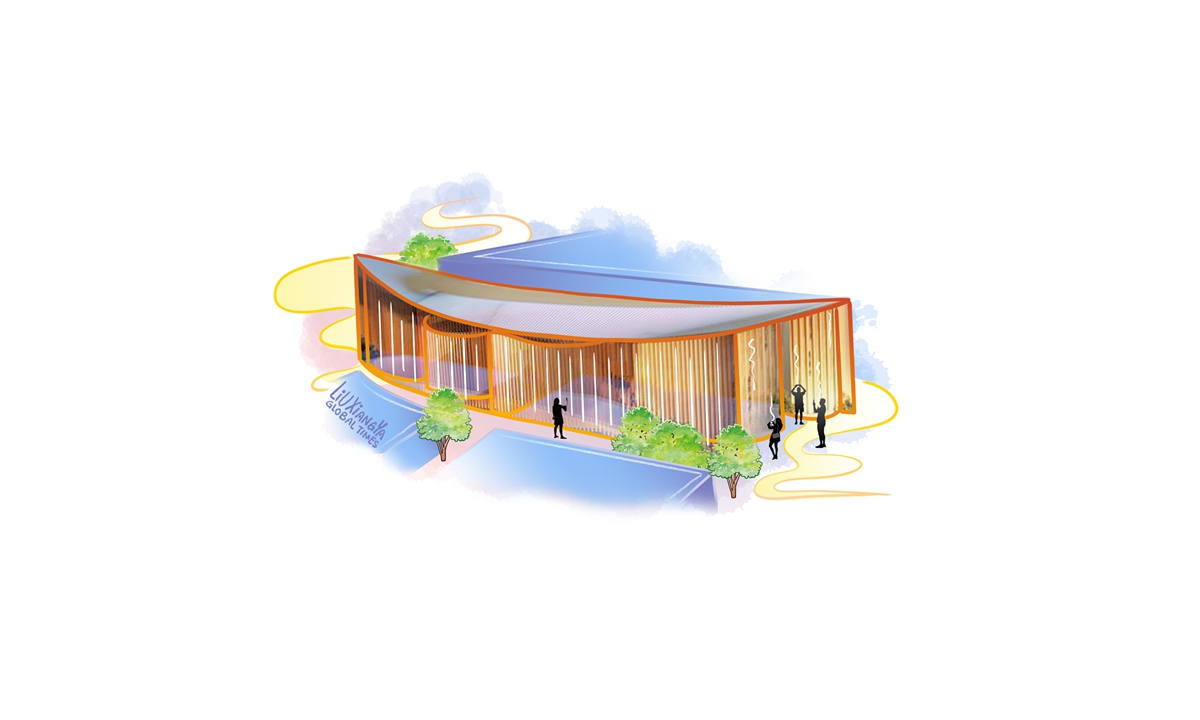
The Aarchitecture design of the Chinese Pavilion for the World Expo 2025. Illustration: Liu Xiangya
The architecture design of the Chinese Pavilion, called "Inscribed Slips of China," at the approaching Expo 2025 in Osaka, Japan, was recently revealed. As a greeting space that aims to stand out from numerous global pavilions, the "slips" design - minimal and geometric looking with a plain wood color - seems effortless compared to its significant symbolism for representing the Chinese people on the worldwide stage.
Coming up from China's own design group, the China Architecture Design Group, the pavilion may easily evoke viewers' contrasting memories about the "Oriental Crown," the Chinese pavilion design at the Shanghai Expo 2012. Inspired by China's classic wooden tradition dougong and the national color red, the building shouted out loud its Chinese attributes.
Transitioning from "Oriental Crown" to the "Inscribed Slips of China," it is clear to see that the design mentality has shifted from be "outstanding" to "modern yet muted."
Such changes provoke a new inquiry: "Where have the cultural aesthetics in Chinese buildings gone?"
The question won't be addressed if "China's cultural aesthetics" are still equated with symbols like "red lanterns" and "grand roofs" that "exaggeratedly amplify a building," architect Yuan Han told the Global Times. It is obvious that more and more Chinese designers have starting to "turn Chinese beauty into an intrinsic part of a building's function and design."
The "Inscribed Slips of China" is an example. Taking ancient Chinese bamboo slip scrolls as a major inspiration, the "slips building" has integrated the scroll's unfettered lines into the no-column exhibition hall's interior design. Inspired by the gaps that exist between each bamboo slip in an ancient scroll, the architecture has installed a façade that allows natural sunlight to go through designed gaps to light up the space.
New projects like this are a representative example that shows Chinese cultural aesthetics have not been given up in contemporary design but internalized into it.
Yuan, the architect, told the Global Times that such "internalized application" of Chinese aesthetics can also reflect creators' deeper reflections on their Chinese cultural roots.
"Once, we wanted 'China' to be seen by the West-dominated architecture field, so we used obvious signs to direct viewers, but now, modern China has brought designers the confidence to combine local culture with international aesthetics," Yuan noted.
China's developing modernization and its opening-up have accelerated international architectural opportunities in the country's market. This has not only made renowned international firms like the US' OMA, the UK's Foster + Partner and also Japanese masters such as Tadao Ando come to the country, but also has given local designers the opportunity to do projects overseas.
In 2022, the Beijing-based firm MAD facilitated a 13-floor residential building called UNIC for the Paris's Olympic Village eco-district Clichy-Batignolles. Though the project was physically rooted in a European country's land, its design philosophy - "nature urbanism" - is, however, indigenous to China's longstanding philosophy of co-existence between human and nature.
Chinese architect Ma Yansong, the helm of the UNIC project, once told the Global Times that his design shed light on Western modernism with a touch of "Asian sensibility."
"You see the [terrace] lines; their fluidity has a life force. This to me is very Asian. You can find similar aesthetic sensibilities in traditional Chinese landscape art, garden design and literature. The architect also added a "very Asian feeling," which is what's missing in functionality-oriented Western modernist architecture.
With a simplistic outlook, the UNIC is only one of the Chinese made buildings that do not look Chinese yet are completely from China.
URL: https://www.seeglobalnews.com/read-2210.html